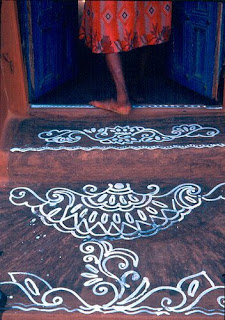Reading and learning more every day about the traditions and stories that
fascinate, inspire and makes me the person I am today. I hope I can honor these
traditions and teach my children to follow them for the adoration and
ornamentation of the earth which sustains us, but equally a ritual invocation
of the Gods for acquiring their blessings more than beautifying the homes. This
year at home its going to much more on a traditional note as always. The more
you read about I am in love with the floor designs a visual prayer created on
the earth.
Rice art on the floor is a representation of the artistic sensibility
of the people of that state of India.Rice art on the floor is known in different names in the whole of Indian Subcontinent. Its quite interesting as we read through the literature and different blogs and books.Kolam in tamilnadu,Rangoli in Gujarat,Karnataka and Maharashtra,Aipan in Himachal Pradesh,Aripan in Bihar,Alpona In West Bengal,Chita in Orissa,Mandana in Rajasthan,Muggu in Andra pradesh and Chowkpurana in UP.
“Drawn with rice powder, lime or chalk, the process of creation is as
important as the finished form. The designs drawn thus on the floor have a
magical power and presence. They were used as welcoming signs at the entrance
of the house, for a guest must be welcomed with grace and elegance. Beauty
being equated with godliness, it was also the symbol of good omen and therefore
is associated with every phase of life. These universal patterns and symbols
were created and revered during rituals” (As explained by d.source.in).The
floor paintings have also been used as protection against evil spirits. While
drawing these rangolis special attention is paid to the fact that the entire
design must be unbroken and must not have any gaps for an evil spirit to enter.
Lived in South India I am quite familiar with the word Kolam. A rice art
which is popular in South India ,basically in Tamilnadu. They are believed to produce cosmic positive energies which benefit people residing in the house".In olden days,
kolams used to be drawn in coarse rice flour, so that the ants don't have to
work that much for to long for a meal. The rice powder is said to invite birds
and other small critters to eat it, thus inviting other beings into one's home
and everyday life: a daily tribute to harmonious co-existence. It is a sign of
invitation to welcome all into the home, and the goddess Lakshmi the "goddess of prosperity".(courtesy:http://dereisnaarbatik.blogspot.in/)
Different commuities,different states have their own variation in decorating
these visual prayers on the floor. Alpana is a sacred art in India, in which
drawing are made using rice powder on floors in front of houses and around
altars. It is known under different names, in different areas of India, most
common 'Rangoli', 'Kolam' and 'Jhoti'. The word Alpana is derived from the
Sanskrit "alimpana", which means "to plaster" or "to
coat with".The circular Alpana is very important and is drawn as a holy
pedestal while worshipping a deity, especially during Lakshmi Puja.Aripan is a
variation of Rangoli, practiced in Bihar. The Aripan floor painting is derived
from the Sanskrit word Alepan (meaning - to smear). It refers to smearing the
ground with cow dung and clay for the purpose of purification. Aripan is a type
of Mithila art that originated in the Mithila region of Bihar, particularly in
the village of Madhubani. The origin of the art is shrouded in mystery. It is
generally believed that it was created during the epic period when King Janak
of Mithila ordered the marriage hall to be decorated for his daughter Sita’s
marriage to Lord Rama. Some vivid descriptions of these wall and floor
paintings are present in Tulsidas’s Ramcharitamanas. Aipan patterns and motifs
are typical to the region of Kumaon. For the Kumaonis, each deity in the Hindu
pantheon has a special symbol and every occasion demands an Aipan of a
different kind. Every Aipan design has a particular meaning attached to it.
A compulsory aspect of Lakshmipuja (is performed during Diwali, the
festival of lights. Diwali marks the end of the harvest season in most of
India) is the alpana drawn by women.These paintings are made with rice powder
mixed with water (for special occasions limestone and red brick powder(Geru)
for contrast are also used and that is a peculiarity of Mandana paintings in
Rajasthan. Modern interpretations have accommodated chalk, and ready-made
rangolis of wood, plastic templates and vinyl stickers). There are several
motifs that are drawn on the floor around the deity's altar. The motifs are
stylized in characteristic ways and incorporate certain patterns associated
with Lakshmi such as the lotus, Lakshmi's feet, Lakshmi's companion owl, the
sun, a ladder, a plough, a fish, betel (the leaf of a vine belonging to the
Piperaceae family, which includes pepper and Kava), shankhalata (a snake) and
sheaves of rice. The alpana represent the world of the goddess and brings good
fortune to the home.
Lakshmi is the Hindu goddess of
wealth, prosperity (both material and spiritual), fortune, and the embodiment
of beauty. She is the consort of the god Vishnu. Also called Mahalakshmi, she
is said to bring good luck and is believed to protect her devotees from all kinds of misery and money-related sorrows.
In Bengal, Lakshmi is worshiped in autumn when the moon is full, the brightest night of the year. It is believed that she showers wealth on this night. She, along with her mount, the great white owl, descends to Earth and takes away the darkness of poverty, stagnation, anger, and laziness from our lives. Her vahana owl represents royalties, penetrating sight and intelligence.
Making alpana is considered an important part of the spiritual process. Not everybody can do alpana, those who can are considered special and admired for their artistic quality. There are rules to be followed making rangoli or kolam. In front of houses the patterns made should be closing, so that evil spirits can't enter. It is best to make the drawing without pausing or lifting your hand to far from the ground. In some places the kolams are made everyday, in other places only during special occasions like marriages and rituals.
It represents a philosophy of life that enthusiastically celebrates the impermanence of knowing and devotes itself to a constant wish to live in the present.
Worshipping Lakshmi isn't just about doing rituals, it's about making a nice home for your family and guests, being creative and fulfilled with what you got. This will bring you happiness and therefore fortune.
 |
| Bengali alpona (image source from here) |
 |
| the door step painting from here |
 |
| Zwaantje Hans making sandcarpet, 1946 ,from here |
 |
| Kolam drawing, Tamil Nadu, India, 2000 |
 |
| For the Tamil festival of Pongal, when the first of the new crop of rice is offered to the Sun God, Surya, elaborate drawings (kolam) made of rice flour are created in front of village houses. Tamil Nadu, India, 2000 |
 |
| image source from here |
 |
| image source from here |
 |
| kolam on the floor |
 |
| image source from here |
 |
| Kolam in a south indian household |
 |
| Mandana painting on the floor |
 |
Mithila Art
|
Information from http://dereisnaarbatik.blogspot.in/2012/07/harmonious-co-existence.html
Information from http://www.dsource.in/resource/rangoli/types-of-rangoli/alpana/index.html
* Scans and information from the book 'The Art of Rice' by Roy W. Hamilton
** Scans from Nederlands Openluchtmuseum Balie BiDoc
*** Scan from the book 'volkskunst der lage landen 1'












































